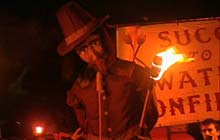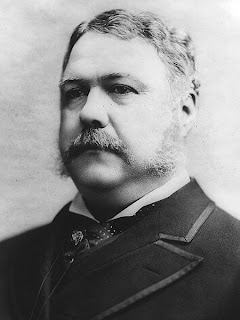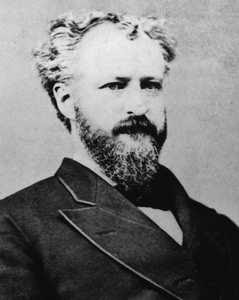 Halloween in the Victorian Era
Halloween in the Victorian EraHalloween thus entered the Victorian era of America: The 1870-1880's. Halloween all of a sudden became less about being scared, celebrating ancestors, and ghosts, but about having parties. Rich people parties. Most of the lore and modes of celebration were thrown out the window, being considered too un-Victorian. Halloween also became a holiday reinterpreted as the quaint practice of the English. They wanted to get rid of the Irish genesis of the holiday. Victorian upper crust hated the Catholics and wanted nothing to do with their evil holiday, so they changed it to fit their needs. On Halloween night, all the young Victorians would gather, have a nice dinner, bob for apples, and play fortune-telling games. These, again, were for the upper middle class and above. Most of the lower middle class to lower class people still celebrated Halloween like the people before them. The Victorians saw it as a holiday to be made safe for their children. It became more about what food to serve, what to decorate with, or how to break the ice at the party. Halloween was still seen as a mysterious night, filled with romance and divination. The tradition of predicting who a girl's husband would be was always popular. These parties, at first, were not for adults though, they were for the unmarried younger crowd. It would seem childish for grownups to be seen at a party of that sort. They were meant to help you find your husband or wife. Themed parties that were trying to be better than the other parties started to sprout up. People threw Cinderella parties, Black Cat parties, and even Mother Goose parties on Halloween night. The spirit of Halloween was starting to be lost among the vast amount of parties during that time of the year. Halloween at the time was extremely watered down, and became more for kids, though parents made sure that they gave a less spooky celebration to their kids. Think of it as the equivalent of your parents going through all your candy looking for razor blades. It was a downer.
It wasn't until the beginning of the 20th century that Halloween began to look like what we see it today. Thanks to groups like the Lion's Club, Boy Scouts of America, and countless other organizations and churches, Halloween became something for everybody, not just a holiday for the rich or for children.
Halloween in the 20th Century

The first town celebration of Halloween started in Anoka, MN, in 1921. The town decorated its streets, hosted two parades, held a Pumpkin Bowl football game and roped off a city square for dancing. Halloween parades and town celebrations became all the rage in America, and soon all regional differences were put aside and Halloween was a holiday for everyone. With this came the "Halloween Problem," which was the rise in pranks and tomfoolery around Halloween. Many organizations tried to get as many kids involved to do service projects as to keep naughty kids busy. Some towns even had the police hire boys who were the most likely to cause trouble, to patrol the streets on Halloween. In Detroit in 1935, the city invited 45,000 kids to 90 public Halloween parties, just to cut down on traffic deaths and false fire alarms. Even though best efforts were being made, vandalism was still a huge problem, especially in cities. The fun stopped in 1942 when the second World War was starting. All of a sudden it was more serious to waste things and vandalize. Kids were warned against letting air out of tires and souping windows, as soup was a valuable thing and Uncle Sam needed it to throw at the Nazi's or something. Halloween was even canceled in some areas, due to the seriousness of the times and people feeling that there should be no tomfoolery. Anything that could be used for the war was, such as materials that would of gone to making decor and other such Halloween things.
After the war, things winded down and everyone started to party again. Halloween was celebrated everywhere again and costume parties became all the rage. Along with that, people started to make "haunted" rooms in their houses to scare guests and children. By the 1950's, Halloween was considered a real national holiday, up there with Christmas and Fourth of July, and the attendance at town Halloween parties rivaled those of Fourth of July celebrations and Memorial day celebrations. With the sudden spurt of children due to all the men coming home from the war (correlation?), Halloween again became a celebration for children. Town parties started to disappear and were replaced by school parties and personal parties. The most important thing added to the Halloween festivities at this time though was Trick or Treating.
Contemporary Halloween
All of a sudden, all of the old t
 raditions came back into the mainstream. Trick or Treating took over the collection of cakes and nuts and became a time for kids to acquire candy from neighbors. The Jack-O-Lantern became more widely used, and the use of fantastic costumes for children while they paraded through the streets became common place. Why did kids expect to get candy from strangers? In the preceding decades, children were given treats to just stay inside and not cause trouble, so, now they went to houses and basically said, "Hey big nose, give me some treats or you're going to get up close and personal with these eggs I got here." As time went on, the trick portion was left for Mischief night, the night before Halloween, or as we call it in Michigan, Devil's Night. In the 60's and 70's, stories started to pop up about people putting heroin or poison into kid's treats. This did happen twice in the span of the two decades, both being deaths attributed to action inside the home. In both cases, a family member tried to kill their relative or kids and used poison in their Pixy Stix. In one case, the father had put a life insurance policy on all his kids. So what does this teach us? That we should suspect our own parents or relatives of murder before we suspect complete strangers. Even though these were isolated incidents, people started to freak out about trick or treating. People started to come up with stories about finding Cyanide in their kid's candy, or glass and razor blades. Though these things never happened, there was a big push to cancel trick or treating out of fear for the children. It was only later after people realized that these were hoax's and that there were no reported trick or treating deaths in the last thirty years, that people warmed back up to Halloween. But, as we all know, the myths about dangerous things in our candy remains to this day.
raditions came back into the mainstream. Trick or Treating took over the collection of cakes and nuts and became a time for kids to acquire candy from neighbors. The Jack-O-Lantern became more widely used, and the use of fantastic costumes for children while they paraded through the streets became common place. Why did kids expect to get candy from strangers? In the preceding decades, children were given treats to just stay inside and not cause trouble, so, now they went to houses and basically said, "Hey big nose, give me some treats or you're going to get up close and personal with these eggs I got here." As time went on, the trick portion was left for Mischief night, the night before Halloween, or as we call it in Michigan, Devil's Night. In the 60's and 70's, stories started to pop up about people putting heroin or poison into kid's treats. This did happen twice in the span of the two decades, both being deaths attributed to action inside the home. In both cases, a family member tried to kill their relative or kids and used poison in their Pixy Stix. In one case, the father had put a life insurance policy on all his kids. So what does this teach us? That we should suspect our own parents or relatives of murder before we suspect complete strangers. Even though these were isolated incidents, people started to freak out about trick or treating. People started to come up with stories about finding Cyanide in their kid's candy, or glass and razor blades. Though these things never happened, there was a big push to cancel trick or treating out of fear for the children. It was only later after people realized that these were hoax's and that there were no reported trick or treating deaths in the last thirty years, that people warmed back up to Halloween. But, as we all know, the myths about dangerous things in our candy remains to this day.Halloween h
 as again become a time for charity though, as many children collect money for UNICEF, or United Nasty Imps Causing Evil Forever. It is only through sheer ignorance that the children collect money from equally ignorant people and further the Imp cause. And of course the dressing up like ancient dead has carried over to our own time, as we dress up like witches, demons, and Hannah Montana.
as again become a time for charity though, as many children collect money for UNICEF, or United Nasty Imps Causing Evil Forever. It is only through sheer ignorance that the children collect money from equally ignorant people and further the Imp cause. And of course the dressing up like ancient dead has carried over to our own time, as we dress up like witches, demons, and Hannah Montana.Halloween has now become a celebration of many things, candy, ghosts, costumes, spooky things, and oh yeah...candy. That's what kids mainly think of these days, is how best to stick it to their parents. Only by completely rotting their teeth can they hit their parents where it hurts...the billfold. Halloween has always been my favorite holiday. I have always loved all the spooky decorations, the ghost stories, walking around getting candy, dressing up like a pirate, and just having a good time being scared. That's something you don't get to do all the time. It's the one time of year where you can go around looking like a bum and actually get food from people as you go begging from house to house. I always enjoyed getting a pop from somebody. They were the ones who for some reason forgot or ran out of candy and had to give you something! Those kind of people also gave out apples, dental floss, pennies, and...sometimes...rocks.
 Hope you enjoyed my history of Halloween! Please feel free to share some favorite Halloween memories that you've had.
Hope you enjoyed my history of Halloween! Please feel free to share some favorite Halloween memories that you've had.Resource:
"Halloween: An American Holiday, an American History" by Lesley Pratt Bannatyne.













